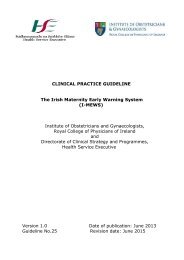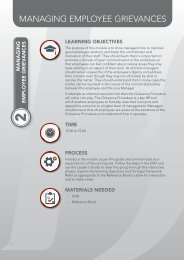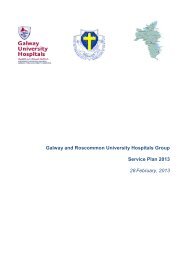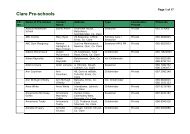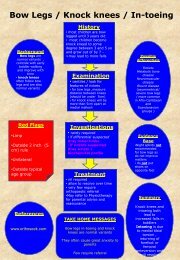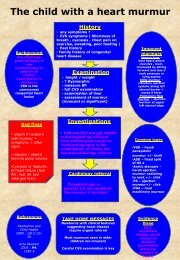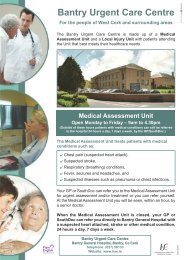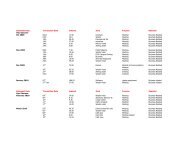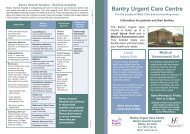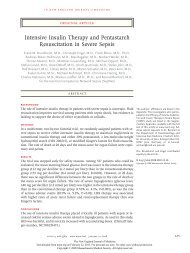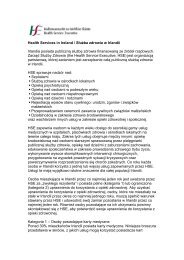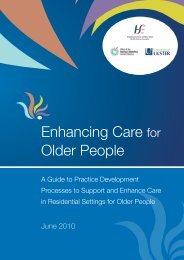Report on the 1st National Acute Hospital Hygiene Audit
Report on the 1st National Acute Hospital Hygiene Audit
Report on the 1st National Acute Hospital Hygiene Audit
You also want an ePaper? Increase the reach of your titles
YUMPU automatically turns print PDFs into web optimized ePapers that Google loves.
<str<strong>on</strong>g>Report</str<strong>on</strong>g> <strong>on</strong> a Nati<strong>on</strong>al <strong>Acute</strong> <strong>Hospital</strong>s <strong>Hygiene</strong><br />
<strong>Audit</strong> undertaken <strong>on</strong> behalf of <strong>the</strong> Nati<strong>on</strong>al<br />
<strong>Hospital</strong>s Office, Health Service Executive<br />
Desford C<strong>on</strong>sultancy Limited<br />
October 2005
C<strong>on</strong>tents<br />
1. Executive summary<br />
2. Introducti<strong>on</strong><br />
3. Terms of reference<br />
4. Scope of audit<br />
5. The audit tool<br />
6. Methodology<br />
7. Limitati<strong>on</strong>s<br />
8. Overall audit scores achieved by hospitals<br />
9. Main findings<br />
10. Discussi<strong>on</strong><br />
11. C<strong>on</strong>clusi<strong>on</strong>s and recommendati<strong>on</strong>s<br />
Appendices<br />
1. NHO schedule of hospitals to be visited<br />
2. <strong>Hospital</strong>/Site numbers, names and overall audit score<br />
3. The audit tool<br />
4. Bar chart of overall hospital scores<br />
5. Bar charts of overall scores for small, medium and large hospitals<br />
6. The score achieved by each hospital for each element and clinical area<br />
7. Bar charts of each element by hospital<br />
8. Bar charts of each clinical area<br />
Acknowledgements<br />
Desford C<strong>on</strong>sultancy would like to thank <strong>the</strong> Infecti<strong>on</strong> C<strong>on</strong>trol Nurses Associati<strong>on</strong> (ICNA) for<br />
its kind permissi<strong>on</strong> to reproduce and use parts of <strong>the</strong> <strong>Audit</strong> Tools for M<strong>on</strong>itoring Infecti<strong>on</strong><br />
C<strong>on</strong>trol Standards 2004.<br />
2
1. Executive summary<br />
This report details <strong>the</strong> results of a nati<strong>on</strong>al acute hospitals hygiene audit undertaken by Desford<br />
C<strong>on</strong>sultancy Limited <strong>on</strong> behalf of <strong>the</strong> Nati<strong>on</strong>al <strong>Hospital</strong>s Office, Health Service Executive<br />
(NHO).<br />
Preventi<strong>on</strong> and c<strong>on</strong>trol of healthcare associated infecti<strong>on</strong> (HAI) is a major challenge for <strong>the</strong><br />
NHO. A number of c<strong>on</strong>cerns were expressed about <strong>the</strong> level of healthcare associated infecti<strong>on</strong><br />
and <strong>the</strong> standards of hygiene in hospitals. In resp<strong>on</strong>se to <strong>the</strong>se c<strong>on</strong>cerns, <strong>the</strong> Director of <strong>the</strong><br />
NHO set up <strong>the</strong> Infecti<strong>on</strong> C<strong>on</strong>trol and Cleaning Standards Working Group to provide guidance<br />
<strong>on</strong> infecti<strong>on</strong> c<strong>on</strong>trol and cleaning services in publicly funded acute healthcare facilities. The<br />
Working Group comprises staff representative of those with resp<strong>on</strong>sibility for and interest in<br />
cleaning and infecti<strong>on</strong> c<strong>on</strong>trol in hospitals throughout <strong>the</strong> country. The development of suitable<br />
standards and <strong>the</strong> facilitati<strong>on</strong> of a nati<strong>on</strong>al hygiene audit to ascertain current levels of hygiene<br />
was an important part of <strong>the</strong> Working Group’s remit.<br />
This is <strong>the</strong> first ever nati<strong>on</strong>al acute hospitals hygiene audit undertaken in Ireland. The results<br />
will be used to establish baseline standards as part of a wider initiative to improve hygiene<br />
levels within <strong>the</strong> healthcare envir<strong>on</strong>ment.<br />
The terms of reference of <strong>the</strong> audit were to undertake a hygiene audit of sample clinical areas at<br />
fifty four acute hospital sites throughout <strong>the</strong> country during July and August 2005. The visits to<br />
each hospital were to be unannounced. The audit findings and recommendati<strong>on</strong>s were to be<br />
documented in a report.<br />
The NHO decided that <strong>the</strong> Infecti<strong>on</strong> C<strong>on</strong>trol Nurses Associati<strong>on</strong> (ICNA) <strong>Audit</strong> Tool for<br />
M<strong>on</strong>itoring Infecti<strong>on</strong> C<strong>on</strong>trol Standards (2004) best reflected <strong>the</strong>ir needs even though it would<br />
not normally be used for a whole hospital audit. Fur<strong>the</strong>rmore, this audit tool acknowledges that<br />
a multidisciplinary approach to hygiene standards is essential. The elements of <strong>the</strong> audit tool<br />
are listed below;<br />
• Envir<strong>on</strong>ment<br />
• Ward/departmental kitchens<br />
• Handling and disposal of linen<br />
• Waste management (hospital wide)<br />
• Departmental waste handling and disposal<br />
• Safe handling and disposal of sharps<br />
• Management of patient equipment<br />
• Hand hygiene<br />
The audit represents a ’spot check’ of standards observed <strong>on</strong> <strong>the</strong> day of <strong>the</strong> visit. The results do<br />
not represent standards throughout each hospital over a period of time. However, <strong>the</strong>y do<br />
provide an indicati<strong>on</strong> of <strong>the</strong> elements that may need addressing <strong>on</strong> a hospital wide basis.<br />
The number of areas audited in each hospital did not reflect a specific sample size. The<br />
maximum number of clinical areas audited per hospital was six. <strong>Hospital</strong> wide waste was<br />
audited at every site.<br />
3
The scores have been categorised and colour coded as follows;<br />
Green indicates good - a score of 85% or above<br />
Blue indicates fair - a score of 76% to 84%<br />
Yellow indicates poor - a score of 75% or below<br />
Using <strong>the</strong> overall hospital score, <strong>the</strong> figure below shows <strong>the</strong> percentage of hospitals in each<br />
category.<br />
FIGURE 1 - HYGIENE RESULTS: ALL HOSPITALS- OVERALL SCORES<br />
% OF HOSPITALS BY CATEGORY<br />
9%<br />
43% Good<br />
Poor<br />
Fair<br />
48%<br />
The figure above illustrates that <strong>the</strong>re is significant improvement required in <strong>the</strong> majority of<br />
hospitals. The main areas of c<strong>on</strong>cern can be summarised as follows;<br />
• Policies and Procedures – <strong>the</strong>re are very few nati<strong>on</strong>al policies in place. The key areas<br />
where policies and procedures require developing are colour coding, linen, waste,<br />
uniforms, ward kitchens, dec<strong>on</strong>taminati<strong>on</strong> and service level agreements.<br />
• <strong>Hospital</strong> accommodati<strong>on</strong> – <strong>the</strong> levels of cleanliness varied between hospitals. In many<br />
cases, it was <strong>the</strong> attenti<strong>on</strong> to detail that was of c<strong>on</strong>cern. In some hospitals space was at a<br />
premium and many wards and departments did not have adequate storage facilities.<br />
Many of <strong>the</strong> hospitals did not have hand washing facilities that complied with current<br />
requirements.<br />
• Maintenance of equipment and building fabric - a number of hospitals require <strong>the</strong> fabric<br />
of <strong>the</strong> building to be improved. Minor and major capital investment may be required to<br />
upgrade facilities to ensure that <strong>the</strong>y meet hygiene requirements. Similarly, it may be<br />
necessary to upgrade some of <strong>the</strong> general use items e.g. waste bins, chairs and tables.<br />
4
• Waste management - in many hospitals <strong>the</strong>re was a lack of resp<strong>on</strong>sibility and<br />
accountability for waste management both at ward/department level and hospital wide.<br />
There was no c<strong>on</strong>sistency in <strong>the</strong> use of colour coding of waste bags.<br />
• Equipment and cleaning materials - a variety of cleaning equipment and materials were<br />
in use across <strong>the</strong> country. In many hospitals, cleaning equipment was out dated or<br />
inappropriate for <strong>the</strong> area. There was little evidence available to c<strong>on</strong>firm that chemicals<br />
were being diluted correctly. There were no nati<strong>on</strong>al specificati<strong>on</strong>s for equipment and<br />
materials.<br />
• Technical support - It was evident in some hospitals that <strong>the</strong> amount of technical<br />
support available in areas such as infecti<strong>on</strong> c<strong>on</strong>trol, waste management, health and<br />
safety and cleaning services was limited. In <strong>the</strong> larger hospitals, technical advice and<br />
support was generally available in all areas whilst <strong>the</strong> smaller sites did not have this and<br />
some expertise was shared within a group of hospitals.<br />
• Training - From <strong>the</strong> evidence provided, <strong>the</strong> level and effectiveness of in-house training<br />
varied across <strong>the</strong> country. The results of <strong>the</strong> audit identified a number of areas where<br />
training may be required.<br />
A comprehensive analysis of results by hospital and element is detailed in <strong>the</strong> report.<br />
It is clear from <strong>the</strong> audit that historically <strong>the</strong>re has not been a cohesive nati<strong>on</strong>al approach to <strong>the</strong><br />
management and improvement of hygiene standards. Each hospital has developed its own<br />
approach to hygiene and this is reflected in <strong>the</strong> different policies and procedures in place.<br />
Informati<strong>on</strong> and best practice has not been shared between hospitals. The establishment of <strong>the</strong><br />
Infecti<strong>on</strong> C<strong>on</strong>trol and Cleaning Standards Working Group represents an important step forward<br />
in developing a nati<strong>on</strong>al approach to improving hygiene standards.<br />
The key recommendati<strong>on</strong>s arising from <strong>the</strong> audit are:<br />
• A multi disciplinary approach is required at nati<strong>on</strong>al and local level if hygiene standards<br />
are to be improved.<br />
• Nati<strong>on</strong>al policies and procedures need to be developed and <strong>the</strong>n implemented at local<br />
level<br />
• Training of staff is essential and a nati<strong>on</strong>al training strategy that supports <strong>the</strong> nati<strong>on</strong>al<br />
policies, procedures and standards needs to be developed.<br />
• The amount of technical support available within hospitals should be reviewed to<br />
ensure that timely and up to date advice is readily available<br />
• A number of multi-disciplinary technical working groups should be c<strong>on</strong>vened to<br />
develop specific standards at a nati<strong>on</strong>al level<br />
• <strong>Hygiene</strong> standards should form part of <strong>the</strong> nati<strong>on</strong>al performance m<strong>on</strong>itoring framework<br />
used by <strong>the</strong> NHO. They should comprise clearly defined objectives with measurable<br />
outcomes.<br />
• A multi-disciplinary audit tool reflecting agreed nati<strong>on</strong>al policies, procedures and<br />
standards should be developed and used in all hospitals.<br />
5
• Whilst hospital General Managers/Chief Executives have ultimate accountability for<br />
hygiene standards, it is recommended that a senior manager at hospital management<br />
team level takes pers<strong>on</strong>al resp<strong>on</strong>sibility for <strong>the</strong> implementati<strong>on</strong> and m<strong>on</strong>itoring of <strong>the</strong><br />
nati<strong>on</strong>al policies, procedures and standards.<br />
• <strong>Hospital</strong> multi-disciplinary working groups should be c<strong>on</strong>vened and <strong>the</strong>y should have<br />
resp<strong>on</strong>sibility for <strong>the</strong> <strong>on</strong>going development, implementati<strong>on</strong> and review of local<br />
hygiene standards. These groups need to develop a hygiene strategy and acti<strong>on</strong> plan<br />
including short, medium and l<strong>on</strong>g term goals that address <strong>the</strong> issues arising out of local<br />
and nati<strong>on</strong>al audits<br />
• <strong>Hospital</strong>s should review <strong>the</strong> skill base of n<strong>on</strong>- clinical staff involved in <strong>the</strong> delivery of<br />
hygiene standards and undertake a gap analysis against <strong>the</strong> nati<strong>on</strong>al training strategy<br />
requirements. Appropriate training programmes should be developed reflecting <strong>the</strong><br />
needs at a local level.<br />
• <strong>Hospital</strong> multi-disciplinary working groups should be required to validate proposals and<br />
sign off plans in relati<strong>on</strong> to minor and major building schemes. It will be important to<br />
ensure that designs, finishes and facilities have a high level of ‘’cleanability’’.<br />
The results of <strong>the</strong> hygiene audit show that <strong>the</strong>re is a need to improve standards in almost all<br />
hospitals. It will be important to build <strong>on</strong> <strong>the</strong> work already started at both nati<strong>on</strong>al and local<br />
level and ensure <strong>the</strong> momentum is maintained. The results provide a baseline which can be used<br />
to measure and m<strong>on</strong>itor improvements in hygiene standards.<br />
6
2. Introducti<strong>on</strong><br />
2.1. This report details <strong>the</strong> results of a nati<strong>on</strong>al acute hospitals hygiene audit undertaken by<br />
Desford C<strong>on</strong>sultancy Limited <strong>on</strong> behalf of <strong>the</strong> Nati<strong>on</strong>al <strong>Hospital</strong>s Office, Health Service<br />
Executive (NHO).<br />
2.2. Within <strong>the</strong> European Community and elsewhere, hygiene standards are recognised as being<br />
an essential comp<strong>on</strong>ent in <strong>the</strong> provisi<strong>on</strong> of quality healthcare. This is <strong>the</strong> first ever nati<strong>on</strong>al<br />
acute hospitals hygiene audit undertaken in Ireland. The results will be used to establish<br />
baseline standards as part of a wider initiative to improve hygiene levels within <strong>the</strong> healthcare<br />
envir<strong>on</strong>ment. The audit covers a number of elements, detailed later in this report, covering<br />
many aspects of hygiene as well as envir<strong>on</strong>mental cleanliness.<br />
2.3. Elsewhere, o<strong>the</strong>r countries are undertaking similar projects to improve hygiene standards.<br />
For example, in England, <strong>the</strong> Healthcare Commissi<strong>on</strong> has recently undertaken a series of<br />
unannounced hospital cleanliness audits. These have been undertaken <strong>on</strong> a sample basis and <strong>the</strong><br />
results are due to be published in autumn 2005.<br />
2.4. Preventi<strong>on</strong> and c<strong>on</strong>trol of healthcare associated infecti<strong>on</strong> (HAI) is a major challenge for <strong>the</strong><br />
Health Service Executive (HSE). <strong>Hospital</strong> and clinical managers must ensure that <strong>the</strong>y have<br />
effective systems in place to minimize <strong>the</strong> risks of infecti<strong>on</strong> to patients, staff and visitors.<br />
2.5. <strong>Hygiene</strong> standards rely <strong>on</strong> a multi disciplinary approach being adopted within each<br />
hospital. The cleaning service provided, whe<strong>the</strong>r in-house or c<strong>on</strong>tracted out, is <strong>on</strong>e of <strong>the</strong><br />
crucial comp<strong>on</strong>ents of a hospital hygiene system. A clean hospital can make a difference to<br />
how patients feel about how <strong>the</strong>y have been treated. A clean envir<strong>on</strong>ment is also key to<br />
reducing healthcare associated infecti<strong>on</strong>s and is important for efficient and effective healthcare.<br />
Similarly, <strong>the</strong> practices adopted by clinical staff, <strong>the</strong> maintenance of <strong>the</strong> estate and waste<br />
management all impact significantly <strong>on</strong> hygiene standards<br />
2.6. Following c<strong>on</strong>cern about healthcare associated infecti<strong>on</strong> and standards of hygiene in<br />
hospitals, Mr. Pat McLoughlin, Director of <strong>the</strong> NHO, set up <strong>the</strong> Infecti<strong>on</strong> C<strong>on</strong>trol and Cleaning<br />
Standards Working Group to provide guidance <strong>on</strong> infecti<strong>on</strong> c<strong>on</strong>trol and cleaning services in<br />
publicly funded acute care facilities. The Working Group comprises staff representative of<br />
those with resp<strong>on</strong>sibility for and interest in cleaning and infecti<strong>on</strong> c<strong>on</strong>trol in hospitals<br />
throughout <strong>the</strong> country. The development of suitable standards and <strong>the</strong> facilitati<strong>on</strong> of a nati<strong>on</strong>al<br />
hygiene audit to ascertain current levels of hygiene was an important part of <strong>the</strong> Working<br />
Group’s remit.<br />
3. Terms of Reference<br />
3.1. The terms of reference, as defined by <strong>the</strong> Health Service Executive, through <strong>the</strong> Nati<strong>on</strong>al<br />
<strong>Hospital</strong>s Office, were to undertake a hygiene audit of sample clinical areas in acute hospitals<br />
throughout <strong>the</strong> country during July and August 2005. The visits to each hospital were to be<br />
unannounced. The audit findings and recommendati<strong>on</strong>s were to be documented in a report, <strong>the</strong><br />
first draft of which was to be completed by <strong>the</strong> 30th September 2005.<br />
7
3.2. The specific outcomes required were as follows:<br />
• To establish current levels of hygiene in selected clinical areas<br />
• To advise <strong>on</strong> <strong>the</strong> existence of standards<br />
• To make recommendati<strong>on</strong>s <strong>on</strong> <strong>the</strong> future development of hygiene standards<br />
3.3. The Nati<strong>on</strong>al <strong>Hospital</strong>s Office identified <strong>the</strong> sample clinical areas as:<br />
• Accident and Emergency Department<br />
• Surgical Ward<br />
• Medical Ward<br />
• Intensive Care Unit<br />
• Outpatients Department<br />
• Specialist area (e.g. Orthopaedics, Paediatrics, Maternity, Gynaecology)<br />
3.4. Fur<strong>the</strong>rmore, <strong>the</strong> elements to be audited were defined as:<br />
• Envir<strong>on</strong>ment<br />
• Ward/departmental kitchens<br />
• Handling and disposal of linen<br />
• Waste management (hospital wide)<br />
• Departmental waste handling and disposal<br />
• Safe handling and disposal of sharps<br />
• Management of patient equipment<br />
• Hand hygiene<br />
4. Scope of <strong>the</strong> <strong>Audit</strong><br />
4.1. The NHO provided a schedule of hospitals/sites to be visited and <strong>the</strong> areas to be audited.<br />
This is shown in Appendix 1. In total <strong>the</strong>re were 54 hospital sites identified in <strong>the</strong> schedule. The<br />
number of areas audited per hospital ranges between 2 and 6 (as per Appendix 1). The size of<br />
<strong>the</strong> sample in each hospital was based <strong>on</strong> <strong>the</strong> different clinical areas present and not <strong>on</strong> a<br />
percentage of <strong>the</strong> total number of areas within each site. In additi<strong>on</strong> <strong>the</strong> management of waste at<br />
a hospital level has been audited <strong>on</strong> all sites. Each hospital has been allocated a number and this<br />
is used throughout this report. Appendix 2 lists <strong>the</strong> hospitals, <strong>the</strong>ir respective number and<br />
overall audit score.<br />
5. The <strong>Audit</strong> Tool<br />
5.1. The NHO reviewed a number of tools and c<strong>on</strong>sidered <strong>the</strong> appropriateness, strengths and<br />
weaknesses of each. They c<strong>on</strong>cluded that <strong>the</strong> Infecti<strong>on</strong> C<strong>on</strong>trol Nurses Associati<strong>on</strong> (ICNA)<br />
<strong>Audit</strong> Tool for M<strong>on</strong>itoring Infecti<strong>on</strong> C<strong>on</strong>trol Standards (2004) best reflected <strong>the</strong>ir needs even<br />
though it would not normally be used for a whole hospital audit. Fur<strong>the</strong>rmore, it is understand<br />
that Infecti<strong>on</strong> C<strong>on</strong>trol Nurses and o<strong>the</strong>r staff with a resp<strong>on</strong>sibility for hygiene and infecti<strong>on</strong><br />
c<strong>on</strong>trol in Ireland are familiar with and use this audit tool.<br />
8
5.2. The Infecti<strong>on</strong> C<strong>on</strong>trol and Cleaning Standards Working Group decided to exclude two<br />
elements and a number of questi<strong>on</strong>s from <strong>the</strong> tool as <strong>the</strong>y were deemed to be outside of <strong>the</strong><br />
remit of <strong>the</strong> hygiene audit. Agreement to use <strong>the</strong> tool in its modified form was given by <strong>the</strong><br />
ICNA.<br />
5.3. The elements excluded are detailed below:<br />
• The Management of Patient Equipment in Specialist Areas (secti<strong>on</strong> 4.8 of <strong>the</strong> audit<br />
tool). This secti<strong>on</strong> covers specialist areas such as physio<strong>the</strong>rapy, occupati<strong>on</strong>al <strong>the</strong>rapy<br />
and dermatology departments that were not included in <strong>the</strong> scope of <strong>the</strong> audit.<br />
• Clinical Practice (secti<strong>on</strong> 4.10 of <strong>the</strong> audit tool) The ICNA advise that, ‘’<strong>the</strong> clinical<br />
practice audit should be completed over a period of time to allow for <strong>the</strong> observati<strong>on</strong> of<br />
as many practice elements as possible. The assistance of link pers<strong>on</strong>nel and ward staff<br />
may be required to achieve this.’’ Due to <strong>the</strong> timescale of <strong>the</strong> audit this would not be<br />
achievable and was <strong>the</strong>refore excluded.<br />
5.4. Six secti<strong>on</strong>s from <strong>the</strong> Management of Patient Equipment (general) element (secti<strong>on</strong> 4.7<br />
questi<strong>on</strong>s 16 to 39) were excluded as <strong>the</strong>y were also deemed to be outside <strong>the</strong> remit of <strong>the</strong> audit.<br />
5.5. Similarly, eight o<strong>the</strong>r questi<strong>on</strong>s were deemed not to be applicable within <strong>the</strong> Irish<br />
healthcare envir<strong>on</strong>ment as ei<strong>the</strong>r a nati<strong>on</strong>al standard did not exist or time c<strong>on</strong>straints would not<br />
allow for <strong>the</strong> observati<strong>on</strong>s of procedures. The questi<strong>on</strong>s deemed to be not applicable were:<br />
• 4.2 Ward/department kitchens. Questi<strong>on</strong> 15- There is a <strong>the</strong>rmometer in <strong>the</strong> fridge and<br />
freezer<br />
• 4.4 Waste Management. Questi<strong>on</strong> 20- Biological agents are made safe by autoclaving<br />
before leaving <strong>the</strong> laboratory for final disposal<br />
• 4.4 Waste Management. Questi<strong>on</strong> 32- Supplies of mattress bags are available and are<br />
used for c<strong>on</strong>taminated mattresses ready for disposal<br />
• 4.5 Departmental waste handling and disposal. Questi<strong>on</strong> 12- All prescripti<strong>on</strong> <strong>on</strong>ly<br />
medicines must be disposed of as hazardous/special waste and <strong>the</strong> bin labeled<br />
accordingly<br />
• 4.6 Safe handling and disposal of sharps. Questi<strong>on</strong> 5- All sharps’ bins are labeled and<br />
signed according to hospital policy<br />
• 4.9 Hand <strong>Hygiene</strong>. Questi<strong>on</strong> 7- Antibacterial soluti<strong>on</strong>s are used for invasive procedures<br />
and surgical scrubs<br />
• 4.9 Hand <strong>Hygiene</strong>. Questi<strong>on</strong> 22- Patients are offered hand hygiene facilities after using<br />
<strong>the</strong> toilet/commode/bedpan e.g. hand wipe<br />
• 4.9 Hand hygiene. Questi<strong>on</strong> 23- Patients are offered hand hygiene facilities prior to<br />
meals<br />
5.6. Apart from <strong>the</strong>se exclusi<strong>on</strong>s, <strong>the</strong> audit tool has remained as devised by <strong>the</strong> Infecti<strong>on</strong><br />
C<strong>on</strong>trol Nurses Associati<strong>on</strong>. A blank copy of <strong>the</strong> audit questi<strong>on</strong>naire used is shown in<br />
Appendix 3.<br />
9
Elements of <strong>the</strong> audit tool<br />
5.7. The audit tool comprises eight elements. Each is designed to achieve a particular standard<br />
and <strong>the</strong>y cover a number of aspects. The standard and areas covered in each element are shown<br />
below.<br />
5.7.1. Envir<strong>on</strong>ment<br />
Standard: The envir<strong>on</strong>ment will be maintained appropriately to reduce <strong>the</strong> risk of cross<br />
infecti<strong>on</strong>.<br />
• Adequate facilities for hand hygiene are available i.e. <strong>on</strong>e wash basin per 6 beds or<br />
enclosed area<br />
• Facilities available including clean and dirty utility, toilets and bathrooms, domestic<br />
rooms and hand washing facilities<br />
• Cleanliness of each of <strong>the</strong> areas in <strong>the</strong> ward or department<br />
• The general state of repair of fixtures, fittings and equipment<br />
• Cleanliness of fixtures, fittings and equipment<br />
• Storage facilities available for cleaning equipment and materials<br />
• The availability of colour coded equipment/cloths<br />
5.7.2. Ward/departmental kitchens<br />
Standard: Kitchens will be maintained to reduce <strong>the</strong> risk of cross infecti<strong>on</strong> in<br />
accordance with legislati<strong>on</strong>.<br />
• Cleanliness of <strong>the</strong> area<br />
• Cleaning materials<br />
• The general state of repair of fixtures, fittings and equipment<br />
• The cleanliness of fixtures, fittings and equipment<br />
• Temperature recording of refrigerator/freezer<br />
• Correct storage of food<br />
• Dish washing facilities<br />
• Availability of hand washing facilities<br />
• Evidence of planned, preventative maintenance of equipment<br />
• The availability of suitable, labelled and clean waste bins<br />
5.7.3. Handling and disposal of linen<br />
Standard: Linen is managed and handled appropriately to prevent cross infecti<strong>on</strong>.<br />
• Adequate storage facilities<br />
• Cleanliness of <strong>the</strong> area<br />
• Segregati<strong>on</strong> and adherence to colour coding policy<br />
• Safe handling of linen, use of protective clothing, safe handling of linen bags<br />
• Safe storage of clean and dirty linen<br />
• Use of local laundry facilities, evidence of planned, preventative maintenance (PPM) of<br />
equipment<br />
10
5.7.4. Waste management (hospital wide)<br />
Standard: Waste is disposed of safely without <strong>the</strong> risk of c<strong>on</strong>taminati<strong>on</strong> or injury and in<br />
accordance with legislati<strong>on</strong>.<br />
• Waste c<strong>on</strong>tractors have appropriate licenses<br />
• There is an adequately trained and designated Waste Officer who has received training<br />
in <strong>the</strong> last 2 years<br />
• All documentati<strong>on</strong> is available and kept for <strong>on</strong>e year e.g. transfer notes and completed<br />
c<strong>on</strong>signment notes.<br />
• A secure, clean, covered and dedicated compound is available with adequate<br />
segregati<strong>on</strong> facilities<br />
• Each category of waste is stored appropriately<br />
• The waste bins are secure, clean and appropriate<br />
• An audit trail is available to physically trace waste to final disposal<br />
• Waste is segregated for transportati<strong>on</strong> within <strong>the</strong> hospital<br />
5.7.5. Departmental waste handling and disposal<br />
Standard: Waste is disposed of safely without <strong>the</strong> risk of c<strong>on</strong>taminati<strong>on</strong> or injury.<br />
• Each category of waste is stored appropriately<br />
• Staff knowledge of segregati<strong>on</strong> procedures<br />
• Staff are appropriately trained<br />
• Waste handling<br />
• Waste is stored securely<br />
• Waste bins are clean and appropriate<br />
• Waste bags are not tied <strong>on</strong>to trolleys/c<strong>on</strong>tainers<br />
5.7.6. Safe handling and disposal of sharps<br />
Standard: Sharps will be handled safely to prevent <strong>the</strong> risk of needle stick injury<br />
• Sharps’ bins comply to nati<strong>on</strong>al standards<br />
• Sharps’ bins are used in accordance with hospital policy<br />
• Safe practice<br />
• Promoti<strong>on</strong> of a sharps policy<br />
• Policy awareness am<strong>on</strong>gst staff<br />
• Sharps’ bins are stored securely<br />
5.7.7. Management of patient equipment<br />
Standard: There is a system in place that ensures as far as reas<strong>on</strong>ably practicable that all<br />
reusable equipment is properly dec<strong>on</strong>taminated prior to use and that <strong>the</strong> risks associated with<br />
dec<strong>on</strong>taminati<strong>on</strong> facilities and processes are adequately managed. All dec<strong>on</strong>taminati<strong>on</strong> must be<br />
undertaken in accordance with local policy and manufacturers’ instructi<strong>on</strong>s.<br />
11
• A dec<strong>on</strong>taminati<strong>on</strong> policy is available at ward/departmental level<br />
• Knowledge of dec<strong>on</strong>taminati<strong>on</strong> policy<br />
• Appropriate storage of surgical instruments<br />
• Cleanliness of patient equipment e.g. IV stands, pillows, wheelchairs<br />
• The resp<strong>on</strong>sibility for cleaning equipment is clearly defined<br />
5.7.8. Hand hygiene<br />
Standard: Hands will be dec<strong>on</strong>taminated correctly and in a timely manner using a cleansing<br />
agent, at <strong>the</strong> facilities available, to reduce <strong>the</strong> risk of cross infecti<strong>on</strong>.<br />
• Adequate facilities for hand washing are available i.e. One wash basin per six beds or<br />
enclosed area<br />
• Facilities are appropriate e.g. taps are automatic or elbow operated in clinical areas<br />
• Availability and cleanliness of hand washing materials/dispensers<br />
• Availability of alcohol rub<br />
• Promoti<strong>on</strong>al materials are clearly displayed<br />
• Staff training has been undertaken<br />
The scoring system<br />
5.8. The ICNA tool requires a score of 85% or more to achieve <strong>the</strong> required level of compliance<br />
that dem<strong>on</strong>strates <strong>the</strong> importance placed <strong>on</strong> c<strong>on</strong>trolling infecti<strong>on</strong> within healthcare<br />
envir<strong>on</strong>ments.<br />
5.9. The scores have been categorised and colour coded as follows;<br />
Green indicates good - a score of 85% or above<br />
Blue indicates fair - a score of 76% to 84%<br />
Yellow indicates poor - a score of 75% or below<br />
5.10. The Infecti<strong>on</strong> C<strong>on</strong>trol Nurses Associati<strong>on</strong> audit tool calculates scores for each element of<br />
<strong>the</strong> audit. The score, expressed as a percentage, is calculated by dividing <strong>the</strong> number of “yes”<br />
answers by <strong>the</strong> total of ‘’yes’’ and ‘’no’’ answers. “Not applicable” answers are excluded from<br />
<strong>the</strong> calculati<strong>on</strong> of <strong>the</strong> percentage score.<br />
For example;<br />
If an element comprises 20 questi<strong>on</strong>s, 12 answers are ‘’yes’’, 4 answers are ‘’no’’ and 4 not<br />
applicable (N/A) <strong>the</strong> score is calculated as follows;<br />
12(yes answers) divided by 16 (<strong>the</strong> total of yes and no answers) multiplied by 100<br />
The score <strong>the</strong>refore in this example would be 75%<br />
12
5.11. The methodology in <strong>the</strong> audit tool to calculate <strong>the</strong> average percentage score where more<br />
than <strong>on</strong>e element has been audited is to add up <strong>the</strong> scores for each element and divide by <strong>the</strong><br />
number of areas audited.<br />
For example:<br />
Envir<strong>on</strong>ment 75%<br />
Ward/departmental kitchens 78%<br />
Handling and disposal of linen 90%<br />
Departmental waste handling and disposal 65%<br />
Safe handling and disposal of sharps 79%<br />
Management of patient equipment 84%<br />
Hand hygiene 89%<br />
Total 560<br />
The average score for this area is 560 divided by 7 equals 80%<br />
5.12. This methodology has been used to calculate <strong>the</strong> hospital average for each element and<br />
has also been used to calculate <strong>the</strong> overall hospital score.<br />
6. Methodology<br />
Preparati<strong>on</strong><br />
6.1. Preparati<strong>on</strong> for <strong>the</strong> project commenced immediately following <strong>the</strong> award of <strong>the</strong> c<strong>on</strong>tract.<br />
Guidance notes were produced by Desford C<strong>on</strong>sultancy Limited and circulated to all auditors.<br />
Each pers<strong>on</strong> involved was an experienced auditor with an in depth knowledge of hygiene<br />
related issues Each auditor was pers<strong>on</strong>ally briefed and inducted by <strong>the</strong> Project Director to<br />
ensure <strong>the</strong> audits were carried out objectively, c<strong>on</strong>sistently and in <strong>the</strong> required format. The<br />
project plan was <strong>the</strong>n devised and teams were allocated specific hospitals to visit during each<br />
week.<br />
6.2. Prior to <strong>the</strong> start of <strong>the</strong> visits, each hospital was notified in writing by <strong>the</strong> NHO of <strong>the</strong><br />
policies, procedures and documentati<strong>on</strong> required <strong>on</strong> <strong>the</strong> day of <strong>the</strong> visit e.g. informati<strong>on</strong> relating<br />
to waste management, colour coding policy. This was required to be available from <strong>the</strong> 4 th July<br />
2005 <strong>on</strong>wards. Similarly, each hospital was required to provide c<strong>on</strong>tact details of <strong>the</strong> key<br />
pers<strong>on</strong>nel at each hospital who would be involved in <strong>the</strong> visit.<br />
C<strong>on</strong>ducting <strong>the</strong> <strong>Audit</strong><br />
6.3. The audits commenced <strong>on</strong> <strong>the</strong> 4 th July 2005 and were undertaken by teams of auditors who<br />
visited all <strong>the</strong> 54 hospital sites involved in <strong>the</strong> survey. All audits were unannounced and <strong>on</strong>e<br />
hospital had a fur<strong>the</strong>r unannounced visit. This was to preserve <strong>the</strong> integrity of <strong>the</strong> process as<br />
<strong>the</strong>re was a suggesti<strong>on</strong> that <strong>the</strong> hospital may have known <strong>the</strong> date of <strong>the</strong> visit. Each team<br />
comprised two auditors and <strong>the</strong> visits were undertaken throughout July and most of August<br />
2005. The Project Director undertook audits every week and was in daily c<strong>on</strong>tact with each<br />
team and <strong>the</strong> NHO Project Leader.<br />
13
6.4. Up<strong>on</strong> arrival at each hospital <strong>the</strong> audit team c<strong>on</strong>tacted <strong>the</strong> nominated pers<strong>on</strong> and <strong>the</strong>n chose<br />
which areas <strong>the</strong>y wished to visit e.g. a surgical ward, a medical ward etc. On entering a<br />
ward/department <strong>the</strong> auditors introduced <strong>the</strong>mselves to <strong>the</strong> pers<strong>on</strong> in charge and c<strong>on</strong>firmed that<br />
it was c<strong>on</strong>venient to carry out <strong>the</strong> audit. In <strong>on</strong>e hospital, an area was excluded from <strong>the</strong> survey<br />
due to clinical issues <strong>on</strong> <strong>the</strong> day of <strong>the</strong> visit. The audits were carried out without reference to<br />
cleaning service specificati<strong>on</strong>s. The audit comprised a physical inspecti<strong>on</strong> based <strong>on</strong> <strong>the</strong><br />
elements and standards in <strong>the</strong> audit tool.<br />
6.5. The standards and processes observed were classed as ei<strong>the</strong>r ‘Yes’ <strong>the</strong>y c<strong>on</strong>form, ‘No’ <strong>the</strong>y<br />
do not c<strong>on</strong>form or ‘Not Applicable’. The latter category was used to indicate that a questi<strong>on</strong><br />
was ei<strong>the</strong>r not applicable to <strong>the</strong> area e.g. pressure relieving mattresses in OPD or if <strong>the</strong> standard<br />
or process was not observed at <strong>the</strong> time of <strong>the</strong> visit e.g. staff were not available to answer<br />
questi<strong>on</strong>s.<br />
6.6. The informati<strong>on</strong> from <strong>the</strong> audit was entered into specially devised computer software,<br />
verified and <strong>the</strong>n <strong>the</strong> scores were calculated for each hospital.<br />
7. Limitati<strong>on</strong>s<br />
7.1. The audit represents a ‘spot check’ of standards observed <strong>on</strong> <strong>the</strong> day of <strong>the</strong> visit. The<br />
results do not represent standards throughout each hospital over a period of time. However,<br />
<strong>the</strong>y do provide an indicati<strong>on</strong> of <strong>the</strong> elements that may need addressing <strong>on</strong> a hospital wide<br />
basis. The timescales involved did not allow <strong>the</strong> opportunity to revisit areas if a particular<br />
element was not observed or staff was unavailable at <strong>the</strong> time of <strong>the</strong> visit. C<strong>on</strong>sequently, a ‘Not<br />
Applicable’ entry may appear against a particular questi<strong>on</strong> in some areas even though <strong>the</strong><br />
standard or questi<strong>on</strong> was applicable to <strong>the</strong> area.<br />
7.2. The number of areas audited in each hospital did not reflect a specific sample size. The<br />
maximum number of clinical areas audited was six plus hospital wide waste, irrespective of <strong>the</strong><br />
hospital size. C<strong>on</strong>sequently within <strong>the</strong> large and medium sized hospitals <strong>the</strong> number of areas<br />
audited, as a percentage of <strong>the</strong> total hospital, is relatively low but in <strong>the</strong> smaller hospitals <strong>the</strong><br />
percentage may be higher.<br />
8. Overall hospital scores<br />
8.1. Overall scores for each hospital have been calculated and <strong>the</strong>se are shown in bar chart form<br />
in Appendix 4. The overall average score per hospital has been calculated using <strong>the</strong><br />
methodology specified in <strong>the</strong> Infecti<strong>on</strong> C<strong>on</strong>trol Nurses Associati<strong>on</strong> audit tool.<br />
8.2. The pie chart below represents <strong>the</strong> overall hospital scores categorised as good, fair and<br />
poor.<br />
14
FIGURE 1 - HYGIENE RESULTS: ALL HOSPITALS- OVERALL SCORES<br />
% OF HOSPITALS BY CATEGORY<br />
9%<br />
43% Good<br />
Poor<br />
Fair<br />
48%<br />
8.3. The overall scores have also been classified into small (100 beds or less), medium (101 to<br />
300) and large (more than 301 beds). These results are shown in Appendix 5.<br />
8.4. The pie charts below represent <strong>the</strong> hospital scores classified as small, medium and large<br />
and categorised as good, fair and poor.<br />
FIGURE 2 - HYGIENE RESULTS: LARGE HOSPITALS MORE THAN 300 BEDS<br />
OVERALL SCORES<br />
% OF HOSPITALS BY CATEGORY<br />
18%<br />
35% Good<br />
47%<br />
Poor<br />
Fair<br />
15
FIGURE 3 - HYGIENE RESULTS: MEDIUM HOSPITALS BETWEEN 101 AND 300 BEDS<br />
OVERALL SCORES<br />
% OF HOSPITALS BY CATEGORY<br />
50%<br />
4%<br />
46%<br />
8.5. The scores achieved by each hospital for each element and each clinical area audited are<br />
shown in Appendices 6, 7 and 8.<br />
Good<br />
Poor<br />
Fair<br />
FIGURE 4 - HYGIENE RESULTS: SMALL HOSPITALS 100 BEDS OR LESS<br />
OVERALL SCORES<br />
% OF HOSPITALS BY CATEGORY<br />
33%<br />
11%<br />
56%<br />
Good<br />
Poor<br />
Fair<br />
16
9. Main findings<br />
9.1. This secti<strong>on</strong> of <strong>the</strong> report details <strong>the</strong> main findings from each of <strong>the</strong> elements of <strong>the</strong> audit<br />
and also provides a general overview. The findings are based <strong>on</strong> <strong>the</strong> main <strong>the</strong>mes arising from<br />
<strong>the</strong> audit of <strong>the</strong> fifty four hospital sites. The score achieved by each hospital for each element<br />
and clinical area audited is shown in Appendix 6. The overall scores for each hospital for each<br />
element are shown as bar charts in Appendix 7. The overall scores for each hospital for each<br />
type of clinical area are shown as bar charts in Appendix 8.<br />
General findings<br />
9.2. The general findings are:<br />
• It was evident from <strong>the</strong> audits that <strong>the</strong>re is a significant amount of work being<br />
undertaken within hospitals to improve hygiene standards but <strong>the</strong> results as shown in<br />
Figure 1 above highlight <strong>the</strong> breadth of work still to be undertaken.<br />
• The pie charts shown in Figures 2, 3 and 4 above show that <strong>the</strong> overall results do not<br />
significantly vary between small, medium and large hospitals.<br />
• There appears to be little sharing of informati<strong>on</strong> and best practice between hospitals and<br />
in some cases trials are replicated <strong>on</strong> several sites.<br />
• There was a general lack of c<strong>on</strong>sistency in approach and methodology across a number<br />
of elements e.g. waste segregati<strong>on</strong>, colour coding etc. at both a hospital and nati<strong>on</strong>al<br />
level.<br />
Envir<strong>on</strong>ment<br />
9.3. The overall scores for each hospital for this element are shown as a bar chart in Appendix<br />
7. The scores range between 89% and 46%.<br />
• In general <strong>the</strong>re were adequate facilities for hand hygiene. However <strong>the</strong>re were a<br />
number of older hospitals where <strong>the</strong>re was a shortfall.<br />
• Many wards and departments did not have dedicated or adequate storage facilities for<br />
cleaning materials and equipment. Some facilities were shared with ano<strong>the</strong>r ward/<br />
department, some c<strong>on</strong>sisted of a cupboard <strong>on</strong>ly and o<strong>the</strong>rs were outside of <strong>the</strong> area.<br />
Pers<strong>on</strong>al protective clothing was available and appropriately used.<br />
• The majority of areas visited had an identified area for <strong>the</strong> storage of clean and sterile<br />
equipment but this varied from shelves <strong>on</strong>ly to a dedicated room. It is evident from <strong>the</strong><br />
audit that <strong>the</strong> storage areas were not large enough to store supplies and very often<br />
products were stored <strong>on</strong> <strong>the</strong> floor. The majority of <strong>the</strong>se areas had been cleaned to <strong>the</strong><br />
required standard.<br />
• Most areas had a dedicated dirty utility although some shared <strong>the</strong> facility with ano<strong>the</strong>r<br />
ward/department. Within dirty utilities, approximately half did not have separate hand<br />
washing facilities in <strong>the</strong> room; most had a separate sink for equipment dec<strong>on</strong>taminati<strong>on</strong><br />
and a sluice hopper. Where macerators and bed pan washers were installed <strong>the</strong>y were<br />
generally clean and in working order.<br />
• Most bathrooms and washrooms were appropriately used i.e. not used for <strong>the</strong> storage of<br />
equipment. The majority of wards were not using single use pers<strong>on</strong>al items e.g.<br />
shampoo sachets, although this is not currently a requirement in Ireland. The levels of<br />
cleanliness in bathrooms varied and in many areas <strong>the</strong>re was a lack of attenti<strong>on</strong> to detail.<br />
17
In most cases, materials to clean baths/showers/sinks after each patient’s use were not<br />
readily available.<br />
• The cleanliness of toilets and sinks was poor in many areas visited although toilet floors<br />
were generally clean. Most toilets had adequate hand washing facilities but in some<br />
areas, soap and paper towel dispensers were ei<strong>the</strong>r not available or empty. Some areas<br />
had roller towels or hot air dryers in place of paper towels. The majority of toilets for<br />
female use did have a facility for sanitary waste disposal.<br />
• Many wards/departments did not have colour coded cleaning equipment or cloths, or<br />
informati<strong>on</strong> <strong>on</strong> <strong>the</strong> colour coding system in use.<br />
• In patient/clinical areas, <strong>the</strong> majority of lockers, chairs and tables were in a good state of<br />
repair and clean. However, in approximately half of <strong>the</strong> clinical areas visited, some<br />
chairs were not made of an impermeable fabric e.g. vinyl.<br />
• The majority of floors were clean.<br />
• The standard of cleanliness of high and low level surfaces including air vents and fans<br />
was varied.<br />
• The cleanliness of work stati<strong>on</strong> equipment in clinical areas including teleph<strong>on</strong>es,<br />
computers, printers etc was poor in almost half of <strong>the</strong> areas audited.<br />
• Curtains and blinds were generally clean and free from stains and in most areas staff<br />
stated that <strong>the</strong>re was a pre-planned curtain changing programme in place although this<br />
was not documented.<br />
• Of <strong>the</strong> bed frames audited, more than half showed a lack of attenti<strong>on</strong> to detail when<br />
cleaning as evidenced by dust and staining.<br />
• The majority of patient audio equipment and call bells examined were clean.<br />
Ward/departmental kitchens<br />
9.4. The overall scores for each hospital for this element are shown as a bar chart in Appendix<br />
7. The scores range between 93% and 33%.<br />
• The kitchen floors were generally clean but <strong>the</strong>re was a lack of attenti<strong>on</strong> to detail around<br />
edges and corners.<br />
• The majority of fixtures, fittings, shelves, cupboards and drawers were clean and in a<br />
good state of repair.<br />
• The majority of kitchens had a policy regarding visitor and patient access.<br />
• There was no evidence of infestati<strong>on</strong> in kitchens.<br />
• Where <strong>the</strong>re were open windows many did not have fly screens fitted.<br />
• The majority of cleaning materials used were identifiable and stored separately.<br />
• Many kitchens did not have all <strong>the</strong> facilities for hand washing available e.g. liquid soap,<br />
paper towels and a separate hand wash basin.<br />
• Where observed almost all staff washed hands before serving patient meals and drinks.<br />
• In <strong>the</strong> majority of refrigerators audited, patient and staff food was not labelled. The<br />
majority of food products were within <strong>the</strong>ir expiry date. However, most opened food<br />
was not stored in c<strong>on</strong>tainers.<br />
• A number of hospitals did not have planned preventative maintenance for kitchen<br />
equipment.<br />
• In <strong>the</strong> majority of cases tea towels were used for drying equipment, crockery and<br />
surfaces instead of paper roll.<br />
• The majority of waste bins were not labelled and/or were dirty.<br />
18
• It is understood that <strong>the</strong> daily recording of ward/department refrigerators and freezers is<br />
undertaken by catering staff and records kept in <strong>the</strong> catering department. A requirement<br />
of <strong>the</strong> audit tool is that <strong>the</strong> records are available in <strong>the</strong> ward kitchen.<br />
• Toasters, microwaves and milk coolers were clean in most kitchens.<br />
• At <strong>the</strong> time of <strong>the</strong> audit, some kitchens did not have a temperature probe available for<br />
use with a microwave oven. It is understood that <strong>the</strong>y may be brought from <strong>the</strong> main<br />
kitchen by catering staff at meal times.<br />
• Stock levels of dry goods were very high in some hospitals due to <strong>the</strong> infrequent<br />
delivery schedules that caused problems with storage and stock rotati<strong>on</strong>.<br />
Handling and disposal of linen<br />
9.5. The overall scores for each hospital for this element are shown as a bar chart in Appendix<br />
7. The scores range between 100% and 67%.<br />
• Almost all wards/departments had a clean designated area for <strong>the</strong> storage of clean linen.<br />
• Almost all linen was free from stains.<br />
• In most cases, linen was segregated in appropriate colour coded bags, which were less<br />
than 2/3 full and stored correctly prior to disposal.<br />
• In most cases correct procedures were in use for <strong>the</strong> movement and handling of linen.<br />
• There were five hospitals that had ward-based laundry facilities but <strong>the</strong>re was no<br />
evidence that <strong>the</strong> machines were subject to a pre-planned maintenance programme.<br />
• Where ward based washing machines/washer dryers were used, clear operati<strong>on</strong>al<br />
guidelines and procedures were not always readily available.<br />
Waste management (hospital wide)<br />
9.6. The overall scores for each hospital for this element are shown as a bar chart in Appendix<br />
7. The scores range between 97% and 31%.<br />
• At almost every hospital <strong>the</strong>re was evidence available to show that <strong>the</strong> waste c<strong>on</strong>tractors<br />
were registered with licences.<br />
• More than half of <strong>the</strong> hospitals visited did not have an appropriately designated waste<br />
officer who had underg<strong>on</strong>e training within <strong>the</strong> last two years.<br />
• At <strong>the</strong> time of <strong>the</strong> audit, many hospitals could not show evidence of all <strong>the</strong> required<br />
documentati<strong>on</strong> relating to transfer and final disposal of waste. In some cases <strong>the</strong><br />
informati<strong>on</strong> was kept off site at ano<strong>the</strong>r hospital.<br />
• More than half of all hospitals had a secure, clean, covered and dedicated compound<br />
available with adequate segregati<strong>on</strong> facilities.<br />
• UN (United Nati<strong>on</strong>s) approved rigid c<strong>on</strong>tainers are used for <strong>the</strong> transportati<strong>on</strong> of clinical<br />
waste at all hospitals and virtually all returned c<strong>on</strong>tainers were clean although many<br />
c<strong>on</strong>tainers were found to have broken locks. It is understood that <strong>the</strong> waste c<strong>on</strong>tractor is<br />
resp<strong>on</strong>sible for <strong>the</strong> maintenance of <strong>the</strong> bins whilst <strong>the</strong> hospitals are required to m<strong>on</strong>itor<br />
<strong>the</strong>ir cleanliness and state of repair.<br />
• The majority of sharps boxes were correctly sealed but <strong>the</strong>y were not safely stored as<br />
<strong>the</strong>y were in unlocked bins.<br />
• In <strong>the</strong> majority of hospitals, special waste was stored separately to o<strong>the</strong>r waste.<br />
• There was no evidence provided by hospitals to show that <strong>the</strong>y had carried out an audit<br />
trail to physically trace waste from <strong>the</strong> hospital to <strong>the</strong> point of final disposal.<br />
19
• In most hospitals <strong>the</strong>re was a system for transporting waste through <strong>the</strong> hospital but <strong>the</strong><br />
clinical waste was not always segregated from o<strong>the</strong>r waste.<br />
• In most hospitals a record was kept of <strong>the</strong> coded tags issued to each ward/department.<br />
• Many wards/departments did not have a clinical waste storage area away from <strong>the</strong><br />
public. This was usually due to <strong>the</strong> limited amount of storage space available.<br />
Departmental waste handling and disposal<br />
9.7. The overall scores for each hospital for this element are shown as a bar chart in Appendix<br />
7. The scores range between 93% and 43%.<br />
• It is understand that a nati<strong>on</strong>al waste management policy is not in place.<br />
• The majority of areas displayed posters detailing <strong>the</strong> requirements for waste<br />
segregati<strong>on</strong>.<br />
• Approximately half of all areas visited had waste bins which were enclosed, foot<br />
operated, lidded and in good working order.<br />
• Apart from bins in ward/department kitchens, <strong>the</strong> majority of waste bins were clean.<br />
• The majority of internal storage facilities were unlocked and/or accessible to <strong>the</strong> public.<br />
• Almost all staff were aware of waste segregati<strong>on</strong> procedures and <strong>the</strong> majority had<br />
attended a training sessi<strong>on</strong>.<br />
• Most staff were using <strong>the</strong> correct waste bags although in many areas <strong>the</strong>re was a lack of<br />
bins for <strong>the</strong> disposal of glass. In some hospitals blue waste bags were used for both<br />
clinical and domestic waste. This was not detailed in <strong>the</strong> hospital waste policy.<br />
Safe handling and disposal of sharps<br />
9.8. The overall scores for each hospital for this element are shown as a bar chart in Appendix<br />
7. The scores range between 94% and 61%.<br />
• All sharps’ bins used complied with UN standards and almost all had been assembled<br />
correctly.<br />
• Almost all staff questi<strong>on</strong>ed were aware of <strong>the</strong> procedure following an inoculati<strong>on</strong> injury.<br />
• Almost all wards/departments had a policy or poster available regarding <strong>the</strong><br />
management of an inoculati<strong>on</strong> injury.<br />
• The temporary closure mechanism <strong>on</strong> sharps’ bins was not generally used.<br />
• Generally sharps’ bins were not stored securely and/or away from public access when<br />
sealed and locked. This may be due to a lack of secure storage space at ward/department<br />
level.<br />
• An empty sharps’ bin was not always available <strong>on</strong> <strong>the</strong> cardiac arrest trolley but when<br />
available, it was usually safely secured.<br />
• In <strong>the</strong> majority of areas clean sharps’ trays with integral and compatible bins were<br />
available.<br />
• At <strong>the</strong> time of <strong>the</strong> visit, in almost every area, needles and syringes were disposed of<br />
appropriately and at <strong>the</strong> point of use.<br />
20
Management of patient equipment<br />
9.9. The overall scores for each hospital for this element are shown as a bar chart in Appendix<br />
7. The scores range between 96% and 52%.<br />
• In virtually all wards/departments visited, <strong>the</strong> resp<strong>on</strong>sibility for cleaning patient<br />
equipment was understood by <strong>the</strong> member of staff in charge. They could also describe<br />
<strong>the</strong> cleaning procedure used. However, <strong>on</strong>ly a small number of hospitals had <strong>the</strong><br />
resp<strong>on</strong>sibilities specified in writing.<br />
• Although staff were aware of <strong>the</strong> need for equipment to be dec<strong>on</strong>taminated prior to<br />
repair, many staff were unclear as to <strong>the</strong> documentati<strong>on</strong> required.<br />
• The majority of staff questi<strong>on</strong>ed could not describe <strong>the</strong> symbol used to indicate single<br />
use items.<br />
• A dec<strong>on</strong>taminati<strong>on</strong> policy was available in almost all wards and departments.<br />
• Very few areas undertook local dec<strong>on</strong>taminati<strong>on</strong> of instruments in clinical areas and<br />
most were stored correctly prior to collecti<strong>on</strong> for dec<strong>on</strong>taminati<strong>on</strong> elsewhere.<br />
• The majority of patient equipment e.g. IV stands, pillows, wheelchairs, was visibly<br />
clean.<br />
Hand hygiene<br />
9.10. The overall scores for each hospital for this element are shown as a bar chart in Appendix<br />
7. The scores range between 90% and 50%.<br />
• In general <strong>the</strong>re were adequate facilities for hand hygiene. However <strong>the</strong>re were a<br />
number of older hospitals were <strong>the</strong>re was a shortfall.<br />
• Only <strong>on</strong>e hospital had visible <strong>the</strong>rmostatic mixing valves fitted to hand wash basins in<br />
clinical areas.<br />
• In <strong>the</strong> majority of clinical areas, taps were automatic or elbow operated. However most<br />
wash hand basins did not c<strong>on</strong>form to HBN (<strong>Hospital</strong> Building Note) 95 i.e. <strong>the</strong>y had<br />
overflows, plugs or <strong>the</strong> water jet flowed directly into <strong>the</strong> plug hole.<br />
• The majority of areas had liquid, single use, cartridge soap dispensers available at wash<br />
hand basins although in some areas, bar soap and refillable soap dispensers were<br />
observed.<br />
• In many areas, <strong>the</strong> cleanliness of hand wash basins, taps, splash backs and dispenser<br />
nozzles was not to <strong>the</strong> required standard.<br />
• Alcohol rub was generally available at <strong>the</strong> point of care and was also portable for<br />
clinical procedures. However in most areas, it was not available at <strong>the</strong> point of entry and<br />
exit to wards/departments.<br />
• Some staff involved in patient care were observed wearing jewellery.<br />
• Posters promoting <strong>the</strong> importance of hand hygiene were clearly displayed in most areas.<br />
• The majority of staff c<strong>on</strong>firmed that <strong>the</strong>y had received training in hand hygiene and<br />
training records were also validated. Where available, <strong>the</strong> training material used<br />
appeared thorough and many staff also commented that <strong>the</strong>y had practical<br />
dem<strong>on</strong>strati<strong>on</strong>s at ward level <strong>on</strong> a regular basis.<br />
21
10. Discussi<strong>on</strong><br />
This secti<strong>on</strong> of <strong>the</strong> report reviews <strong>the</strong> findings using a number of topic headings and explores in<br />
more detail <strong>the</strong> underlying issues. The comments have been compiled using evidence from <strong>the</strong><br />
audit findings.<br />
10.1. Policies and Procedures<br />
10.1.1. It was evident from interviews with staff that most were aware of <strong>the</strong> policies and<br />
procedures in place but some did not know where to find <strong>the</strong> documentati<strong>on</strong>. Where available,<br />
<strong>the</strong> informati<strong>on</strong> was not always c<strong>on</strong>cise or user friendly.<br />
10.1.2. The informati<strong>on</strong> below highlights <strong>the</strong> main areas where policies and procedures have an<br />
impact <strong>on</strong> hygiene standards:<br />
10.1.2.1. Colour coding<br />
• The aim of a colour coding system is to prevent cross c<strong>on</strong>taminati<strong>on</strong>.<br />
• A nati<strong>on</strong>al colour coding system is not currently in place.<br />
• The audit revealed a lack of c<strong>on</strong>sistency across <strong>the</strong> country with regard to <strong>the</strong> colours<br />
used for identifying equipment and cleaning cloths. Some hospitals have fully<br />
operati<strong>on</strong>al colour coding systems in place for cleaning equipment (mops, buckets etc.)<br />
pers<strong>on</strong>al protective equipment (gloves, apr<strong>on</strong>s) and cleaning cloths. O<strong>the</strong>r hospitals did<br />
not have a system in place.<br />
• The evidence showed that in some instances, <strong>the</strong> policy found within hospital<br />
documentati<strong>on</strong> differed from that being used at ward/department level. The policy was<br />
not always comprehensive and in some cases was c<strong>on</strong>fusing i.e. <strong>the</strong> use of yellow mop<br />
buckets with blue cloths for ward areas.<br />
• In a few instances <strong>the</strong>re were a number of different systems operating within <strong>the</strong> same<br />
hospital. For example, red cloths provided by <strong>the</strong> catering department for use in ward<br />
kitchens were also <strong>the</strong> colour used by o<strong>the</strong>r staff for cleaning sanitary areas.<br />
Fur<strong>the</strong>rmore, we were informed that if <strong>the</strong> stores department ran out of a particular<br />
coloured cloth, a different coloured cloth was sometimes sent which compromised <strong>the</strong><br />
colour coding system.<br />
10.1.2.2. Linen segregati<strong>on</strong><br />
• A nati<strong>on</strong>al policy for <strong>the</strong> segregati<strong>on</strong> of linen is not in place.<br />
• In a number of hospitals it was observed that <strong>the</strong> linen segregati<strong>on</strong> policy was not fully<br />
implemented at ward level because <strong>the</strong> same coloured linen skip was utilised for both<br />
used and soiled/c<strong>on</strong>taminated linen. Although soiled/c<strong>on</strong>taminated linen was first<br />
segregated into alginate bags, <strong>the</strong>se bags were sometimes mixed with used linen.<br />
• There was a lack of c<strong>on</strong>sistency across hospitals with regard to <strong>the</strong> segregati<strong>on</strong><br />
procedures in place.<br />
22
10.1.2.3. Uniform and work wear<br />
• Whilst staff were observed wearing clean uniforms/work wear which met <strong>the</strong> hospital<br />
requirements, a number of staff involved in patient care were observed wearing<br />
watches, st<strong>on</strong>ed rings and o<strong>the</strong>r wrist jewellery. Staff were also observed off site in<br />
uniforms and <strong>the</strong>atre clothing was worn outside of <strong>the</strong>atres which would suggest that a<br />
detailed uniform policy was ei<strong>the</strong>r not in place or not being followed.<br />
10.1.2.4. Ward/department based kitchens<br />
• The resp<strong>on</strong>sibility for pantries generally comes under <strong>the</strong> remit of <strong>the</strong> catering<br />
department. However, as pantries are remote from <strong>the</strong> main kitchen, it is not always<br />
apparent at ward level which policies/procedures should be followed, and this leads to<br />
poor practice.<br />
• A ward pantry policy would normally include a colour coding system, resp<strong>on</strong>sibilities<br />
and schedules for cleaning, temperature testing of refrigerators/freezers and acti<strong>on</strong><br />
required for n<strong>on</strong> c<strong>on</strong>formance. In additi<strong>on</strong> <strong>the</strong> policy would provide guidance <strong>on</strong><br />
kitchen access, stock rotati<strong>on</strong> and minimum/maximum stock levels, food labelling and<br />
<strong>the</strong> use of microwaves and o<strong>the</strong>r heating/cooking equipment.<br />
10.1.2.5. Dec<strong>on</strong>taminati<strong>on</strong>/cleaning and disinfecti<strong>on</strong> policy<br />
• Very few hospitals used a dec<strong>on</strong>taminati<strong>on</strong> certificate c<strong>on</strong>firming that surgical<br />
equipment to be repaired/serviced had been correctly dec<strong>on</strong>taminated. It is important<br />
that this practice is adopted to minimise cross infecti<strong>on</strong>.<br />
• Many hospitals had policies detailing cleaning and disinfectant processes and an outline<br />
of products to be used for various tasks/equipment. However, it was not always clear by<br />
whom <strong>the</strong> informati<strong>on</strong> was meant to be used by e.g. clinical staff, household staff,<br />
catering, c<strong>on</strong>tractor’s staff or porters. Cleaning products were generally identified by<br />
trade names as opposed to <strong>the</strong> chemical make-up e.g. neutral detergent that could be<br />
c<strong>on</strong>fusing should <strong>the</strong> product no l<strong>on</strong>ger be available or <strong>the</strong> requirements change.<br />
10.1.2.6. Service level agreements<br />
• It is important that staff at ward/department level have a good understanding of <strong>the</strong><br />
cleaning services provided to ensure <strong>the</strong>y meet <strong>the</strong> needs of <strong>the</strong> area. Cleaning<br />
specificati<strong>on</strong>s may not have been reviewed for some time particularly where services<br />
are provided in-house. Service level agreements need to be clearly defined and flexible<br />
in order to meet changing needs. Similarly, this applies to all o<strong>the</strong>r services provided to<br />
wards and departments e.g. waste collecti<strong>on</strong> schedules, curtain changing programmes,<br />
planned preventative maintenance etc.<br />
10.2. <strong>Hospital</strong> accommodati<strong>on</strong><br />
• In many hospitals, internal storage space was at a premium and very often linen and<br />
cleaning equipment rooms were not available. This led to <strong>the</strong> inappropriate storage of<br />
linen and domestic equipment/materials resulting in unsafe practice. Similarly <strong>the</strong>re are<br />
issues around <strong>the</strong> storage of dirty linen and both clinical and domestic waste.<br />
C<strong>on</strong>sequently, although hospitals may have policies in place, in some cases it was<br />
23
physically impossible to comply with storage and segregati<strong>on</strong> requirements. A few<br />
hospitals had resolved some of <strong>the</strong> issues by providing lockable bins <strong>on</strong> corridors or<br />
purpose built mobile linen units.<br />
• There was a shortage of appropriate external space for waste compounds in many<br />
hospitals. A number had provided innovative soluti<strong>on</strong>s to <strong>the</strong> problem that complied<br />
with nati<strong>on</strong>al requirements.<br />
• Where storage space was available, it was often untidy and in some cases c<strong>on</strong>tained<br />
inappropriate items.<br />
• The availability of wash hand basins in some hospitals, particularly older <strong>on</strong>es, did not<br />
meet with <strong>the</strong> required standard and may be difficult to resolve. This was reflected in a<br />
reduced audit score in a number of secti<strong>on</strong>s. Similarly, visible <strong>the</strong>rmostatic mixing<br />
valves fitted to hand wash basins in clinical areas were absent in all but <strong>on</strong>e hospital<br />
visited. In some cases valves may have been c<strong>on</strong>cealed behind fixtures and fittings.<br />
• Due to <strong>the</strong> lack of space in a number of wards/department, shared facilities or rooms<br />
were put to multiple uses e.g. a public toilet was also used as a sluice.<br />
• C<strong>on</strong>versely, in a number of o<strong>the</strong>r hospitals, where space was not an issue, <strong>the</strong> facilities<br />
at ward and department level were poorly utilised.<br />
10.3. Maintenance of equipment and building fabric<br />
• Although <strong>the</strong> quality of <strong>the</strong> building fabric was not part of <strong>the</strong> formal audit, it was<br />
evident from many of <strong>the</strong> visits to hospitals that care and attenti<strong>on</strong> had been paid to <strong>the</strong><br />
internal and external painting, grounds maintenance and general building fabric. A lack<br />
of notices/ poster <strong>on</strong> walls and clutter free corridors and rooms provided <strong>the</strong> visitor with<br />
<strong>the</strong> percepti<strong>on</strong> of a well maintained envir<strong>on</strong>ment. Unfortunately this was not <strong>the</strong> case in<br />
all hospitals.<br />
• In a number of hospitals, some wards and departments were in desperate need of<br />
refurbishment; plasterwork was in a poor state of repair, paint was flaking <strong>on</strong> walls,<br />
skirting boards were badly damaged and <strong>the</strong>re was evidence of damp penetrati<strong>on</strong>.<br />
• Some fixtures and fittings observed were very old, badly damaged and unsuitable for<br />
<strong>the</strong> area e.g. untreated wood shelves in a pantry, fabric chairs in clinical areas.<br />
• Clearly, poor maintenance and <strong>the</strong> timeliness of repairs impacts heavily up<strong>on</strong> <strong>the</strong> ability<br />
of staff to adequately clean areas and <strong>the</strong>refore maintain hygiene standards. An<br />
envir<strong>on</strong>ment that is difficult to clean or keep clean may cost <strong>the</strong> hospital more to<br />
manage.<br />
• There was inc<strong>on</strong>sistency in <strong>the</strong> approach to planned preventative maintenance (PPM)<br />
for ward based dish-washers, ice machines etc. Some hospitals had invested fully in<br />
PPM programmes whilst o<strong>the</strong>rs had made a c<strong>on</strong>scious decisi<strong>on</strong> not to invest. A lack of<br />
PPM may cause operati<strong>on</strong>al problems and in some cases compromise hygiene and<br />
health and safety standards.<br />
• Minor and major capital investment may be required to upgrade facilities to ensure that<br />
<strong>the</strong>y meet hygiene requirements. Similarly, it may be necessary to upgrade some of <strong>the</strong><br />
general use items e.g. waste bins, chairs and tables.<br />
24
10.4. Waste management<br />
• Few hospitals had an appropriately designated waste officer who had underg<strong>on</strong>e<br />
training within <strong>the</strong> last two years. However, even in <strong>the</strong> hospitals where <strong>the</strong>re was a<br />
designated waste officer, compliance levels were not always achieved.<br />
• In many hospitals <strong>the</strong>re was a lack of resp<strong>on</strong>sibility and accountability for waste<br />
management both at ward/department level and hospital wide.<br />
• Whilst it is important to minimise and c<strong>on</strong>trol <strong>the</strong> costs associated with waste disposal,<br />
it should not compromise good practice. For example many hospitals are manually<br />
double handling waste to optimise bin weights which compromises good practice.<br />
• The procedures for validating <strong>the</strong> final disposal of clinical and household waste were<br />
varied and in some cases <strong>the</strong> documentati<strong>on</strong> was not available at <strong>the</strong> time of <strong>the</strong> visit.<br />
This may compromise <strong>the</strong> ability of hospitals to ensure that waste is disposed of<br />
appropriately.<br />
• There was no c<strong>on</strong>sistency in <strong>the</strong> use of colour coding of waste bags. In a number of<br />
instances, blue bags were being used for food, clinical and household waste and were<br />
<strong>the</strong>n put into o<strong>the</strong>r coloured bags within <strong>the</strong> same hospital.<br />
10.5. Equipment and cleaning materials<br />
• The quality and quantity of materials and equipment can impact <strong>on</strong> <strong>the</strong> effectiveness<br />
and efficiency of cleaning.<br />
• A variety of cleaning equipment and materials were in use across <strong>the</strong> country. There<br />
may be an opportunity to improve <strong>the</strong> buying power of hospitals by rati<strong>on</strong>alising <strong>the</strong><br />
products/equipment used.<br />
• In many hospitals cleansing equipment was out dated (deck scrubbers and floor cloths<br />
for mopping) or inappropriate for <strong>the</strong> area (n<strong>on</strong>e vacuum aided burnishing machines in<br />
clinical areas).<br />
• There was little evidence available to c<strong>on</strong>firm or o<strong>the</strong>rwise that chemicals were being<br />
diluted correctly. This can impact <strong>on</strong> <strong>the</strong> product effectiveness, cost and health and<br />
safety.<br />
10.6. Technical support<br />
• It was evident in some hospitals that <strong>the</strong> amount of technical support available in areas<br />
such as infecti<strong>on</strong> c<strong>on</strong>trol, waste management, health and safety and cleaning services<br />
was limited. In <strong>the</strong> larger hospitals, technical advice and support was generally available<br />
in all areas whilst <strong>the</strong> smaller sites did not have this and some expertise was shared<br />
within a group of hospitals.<br />
• It is important that hospitals have sufficient resources available in order to provide<br />
timely and up to date informati<strong>on</strong> <strong>on</strong> hygiene related issues. This is essential if hygiene<br />
standards are to be improved.<br />
25
10.7. Training<br />
• The effectiveness of <strong>the</strong> training was not formally measured. Where provided, <strong>the</strong><br />
quality of <strong>the</strong> training material in most cases was very good. There was a lack of<br />
c<strong>on</strong>sistency with regard to <strong>the</strong> retenti<strong>on</strong> of training records.<br />
• Ongoing training and educati<strong>on</strong> for all grades of clinical and support staff is imperative<br />
to ensure improvements in hygiene standards and safe working practices.<br />
• The results of <strong>the</strong> audit identified a number of areas where training may be required.<br />
The specific areas were:<br />
- Hand hygiene<br />
- Basic cleaning techniques<br />
- C<strong>on</strong>trol of substances hazardous to health (COSHH)<br />
- The use of cleaning chemicals and diluti<strong>on</strong> rates<br />
- Colour coding<br />
- Waste and linen segregati<strong>on</strong><br />
- Safe handling and disposal of sharps<br />
- Manual handling<br />
26
-<br />
11. C<strong>on</strong>clusi<strong>on</strong>s and Recommendati<strong>on</strong>s<br />
11.1. Nati<strong>on</strong>al Level<br />
• It is clear from <strong>the</strong> audit that historically <strong>the</strong>re has not been a cohesive nati<strong>on</strong>al<br />
approach to <strong>the</strong> management and improvement of hygiene standards e.g. no nati<strong>on</strong>al<br />
colour coding or linen segregati<strong>on</strong> policies. There is now a need to build <strong>on</strong> <strong>the</strong> work<br />
already underway at a nati<strong>on</strong>al and local level in order to ensure that <strong>the</strong>re is an agreed<br />
framework for <strong>the</strong> <strong>on</strong>going improvement of hygiene standards.<br />
• It is recommended that a multi disciplinary approach be adopted and that <strong>the</strong>re is a<br />
forum in place for <strong>the</strong> exchange of experiences and best practice.<br />
• <strong>Hygiene</strong> standards should form part of <strong>the</strong> nati<strong>on</strong>al performance m<strong>on</strong>itoring framework<br />
used by <strong>the</strong> NHO. They should comprise clearly defined objectives with measurable<br />
outcomes.<br />
• A number of issues need to be developed nati<strong>on</strong>ally and cascaded down to each hospital<br />
through <strong>the</strong> networks. In particular this would initially involve:<br />
- Agreeing a nati<strong>on</strong>al colour coding policy for cleaning, waste, linen etc. This<br />
would provide a c<strong>on</strong>sistent approach particularly for transient staff and l<strong>on</strong>ger<br />
term reduce training costs.<br />
- Completing <strong>the</strong> development work <strong>on</strong> <strong>the</strong> Nati<strong>on</strong>al Cleaning Standards.<br />
- Developing a generic cleaning specificati<strong>on</strong>/service level agreement for use with<br />
in-house staff and/or c<strong>on</strong>tractors.<br />
- Reviewing and implementing <strong>the</strong> nati<strong>on</strong>al guidelines for <strong>the</strong> management of<br />
waste.<br />
- Developing a generic ward kitchen policy incorporati<strong>on</strong> policies, procedures and<br />
practices.<br />
• Develop a multi-disciplinary audit tool reflecting agreed nati<strong>on</strong>al policies, procedures<br />
and standards.<br />
• Develop a nati<strong>on</strong>al training strategy that supports <strong>the</strong> nati<strong>on</strong>al policies, procedures and<br />
standards.<br />
• C<strong>on</strong>vene a multi-disciplinary technical working group to develop nati<strong>on</strong>al standards and<br />
life cycle costing in relati<strong>on</strong> to:<br />
- Facilities, fixtures, fittings<br />
- Equipment<br />
- Maintenance<br />
- Materials<br />
- C<strong>on</strong>sumables<br />
• Review <strong>the</strong> procurement arrangements following <strong>the</strong> development of nati<strong>on</strong>al<br />
standards and guidelines. There may be a cost benefit if <strong>the</strong> range of products is<br />
rati<strong>on</strong>alised and <strong>the</strong> number of suppliers reduced.<br />
27
11.2. <strong>Hospital</strong> Level<br />
• Whilst hospital General Managers/Chief Executives have ultimate accountability for<br />
hygiene standards, it is recommended that a senior manager at hospital management<br />
team level takes pers<strong>on</strong>al resp<strong>on</strong>sibility for <strong>the</strong> implementati<strong>on</strong> and m<strong>on</strong>itoring of <strong>the</strong><br />
nati<strong>on</strong>al policies, procedures and standards.<br />
• The senior manager should c<strong>on</strong>vene and chair a multi-disciplinary working group<br />
including representatives from Infecti<strong>on</strong> C<strong>on</strong>trol, General Services (household services,<br />
portering and linen services), Cleaning C<strong>on</strong>tractor (if applicable), Human Resources,<br />
Estates, Finance and staff organisati<strong>on</strong>s. This group would have resp<strong>on</strong>sibility for <strong>the</strong><br />
<strong>on</strong>going development, implementati<strong>on</strong> and review of local hygiene standards. Initially<br />
<strong>the</strong> group would:<br />
- Review <strong>the</strong> results and findings of <strong>the</strong> hygiene audit.<br />
- Require all ward and department managers to undertake an internal audit of<br />
hygiene standards.<br />
- Develop a hygiene strategy and acti<strong>on</strong> plan including short, medium and l<strong>on</strong>g<br />
term goals that address <strong>the</strong> issues arising out of local and nati<strong>on</strong>al audits.<br />
- Following <strong>the</strong> producti<strong>on</strong> of <strong>the</strong> agreed nati<strong>on</strong>al policies, procedures and<br />
standards, develop a local implementati<strong>on</strong> plan.<br />
- Develop clearly defined service level agreements for wards and departments.<br />
In <strong>the</strong> l<strong>on</strong>ger term this group would take resp<strong>on</strong>sibility for ensuring that standards are<br />
regularly m<strong>on</strong>itored and improvements acti<strong>on</strong>ed.<br />
• The multi-disciplinary working group would be required to validate proposals and sign<br />
off plans in relati<strong>on</strong> to minor and major building schemes. It will be important to ensure<br />
that designs, finishes and facilities have a high level of ‘cleanability’.<br />
• Review <strong>the</strong> skill base of n<strong>on</strong> clinical staff i.e. household staff, porters, nursing assistants<br />
etc. involved in <strong>the</strong> delivery of hygiene standards. Undertake a gap analysis against <strong>the</strong><br />
nati<strong>on</strong>al training strategy requirements and implement appropriate training programmes.<br />
• Review <strong>the</strong> level of technical support available.<br />
• Undertake a baseline audit to identify <strong>the</strong> c<strong>on</strong>diti<strong>on</strong> of <strong>the</strong> hospital fabric e.g. floors,<br />
walls, ceilings etc. Develop an acti<strong>on</strong> plan to repair or replace defective items.<br />
• Undertake a space utilisati<strong>on</strong> survey with a view to identifying additi<strong>on</strong>al storage space<br />
at ward and department level.<br />
28



